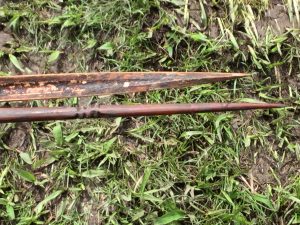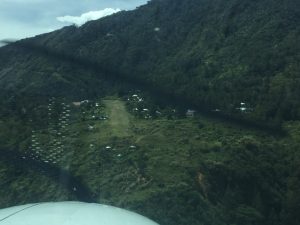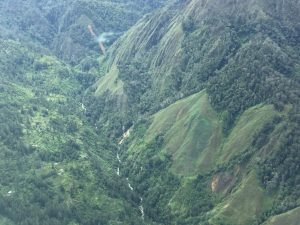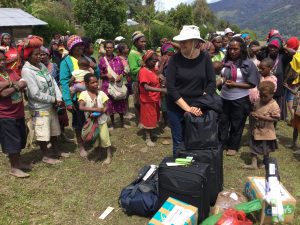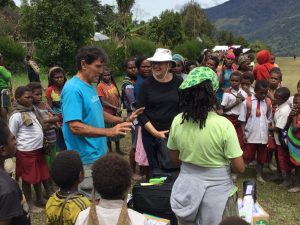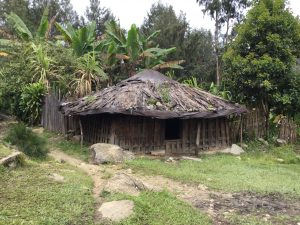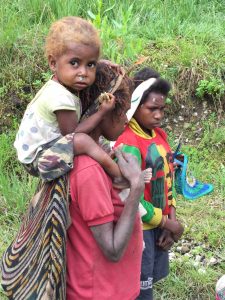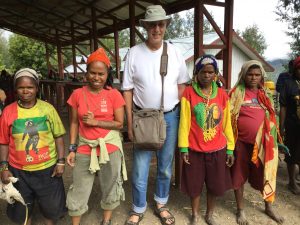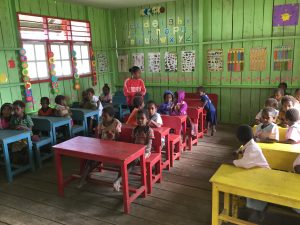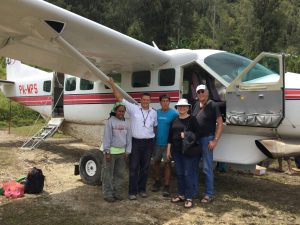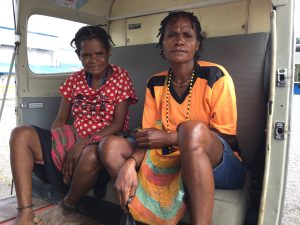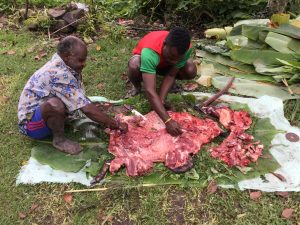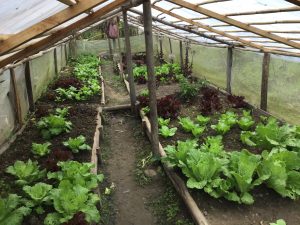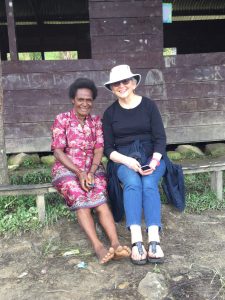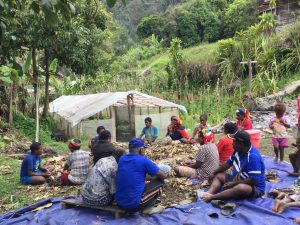Stone Age to the 21st Century in One (Short) Lifetime
Papua is a living laboratory where we can experience the stone age in real time but also observe the process of transition to our modern world. The change is not only clothing and tools but the adaptation of cultural values.
What really marks the end of the Stone Age? Technology, clothing, values? I was told that the two men in the photo might show up tomorrow dressed in opposite styles – a new definition of cross-dressing! They were introduced to metal only 50 years ago but still use many Stone Age tools.
The bows they carry are traditional and unchanged from their Stone Age origins. The arrows have a deadly purpose. Many men whether dressed in shorts or a penis gourd carry their weapons at all times. They have several types of arrows in their quiver. One is designed to kill a pig, another for birds and all carry weapons for war – an arrow specially designed to do maximum damage to another human being. The tip is notched so that it breaks and remains in the body. With a little pig’s blood on the tip it will do its job!
New Guinea, Irian Jaya, Papua or whatever name meets current political realities is the last bastion of the Stone Age – protected by crocodile-infested malarial mangrove swamps along the coasts and the vertical mountain barriers created by the collision of 3 tectonic plates. Dozens of tribes persisted as isolated stone age animists until “discovered” during WWII.
Geography favored isolation. The tectonic forces created not only mountain barriers with sheer cliffs but a highland interior of steep hills and mountains with little discernible pattern and few navigable rivers. The Baliem Valley in West Papua – the part controlled by Indonesia – had the best terrain to support a large population (the Dani) and is accessible today with a jet-capable airport. This brings tourism, development and modernity. The Stone Age is increasingly a curiosity for tourists.
Leona and I had the opportunity to visit a part of West Papua that remains inaccessible except for the incredible airstrips hacked out of hilltops and jungle by the tribesmen – often with Stone Age tools – with the encouragement of a small band of intrepid missionaries. This is the home of the Moni – a Stone Age tribe of about 50,000 with no access other than very difficult trails or these jungle strips. We landed on a local dirt airstrip in the Village of Pogapa. It is situated at 2000 meters altitude. Half of the airstrip has a slope of 15 degrees and the balance 6 degrees. The amazing small planes and pilots land uphill and take off downhill – little room for error.
The first known external or at least western persons to interact with the Moni were a missionary couple from the Christian and Missionary Alliance in 1950. They learned the language and provided the foundation for the ability to develop written materials. They were followed by their son John who together with his wife Joy carry on the relationship with the Moni. The majority of the Moni are Christians today as is true of most of the tribes of Papua.
- I never received such a welcome back home – and it’s all in technicolor!
- John as walked with the Moni from the Stone Age to the edge of the modern world
- A typical Moni hut. Everyone sleeps around a fire.
- It’s not much but that’s all I have to sell today.
Missionaries have often been criticized for changing cultures but these missionaries did not challenge any aspect of their culture such as food or clothing. Today they are the carriers of ideas and initiatives in education, agriculture and community leadership. The challenge faced by these Stone Age cultures is coming to terms with the inexorable arrival of the modern world. Stone Age life was characterized by disease, precarious access to food but most notably superstition and competition for territory and limited resources. The result was short life spans and by our standards an uncompromising response to the reality of their precarious existence. If a mother died in childbirth the tribe had no means of dealing with a surviving infant and the newborn would join the mother in death.
- Your hair would be red too if you had my bad diet.
- No – it’s not in the genes – it’s in the diet.
- Color is in fashion in the Highlands.
- Where will school lead these children?
The response to these challenges was war which in that hostile environment usually consisted of hunting down a member of the “other” by seeking them out when they were alone or working their scattered slash-and-burn fields in the jungle hills. These conflicts could stretch into months and years with tit-for-tat murders. The consequences could be devastating. An entire village or tribe might be prevented from the essential hunting or care of their gardens resulting in starvation.
Whatever our secular criticism of Christian missionaries one of their major contributions was to introduce different values and techniques of conflict resolution. We were unexpected witnesses to one of these moments where Stone Age values are challenged.
There was a violent incident in the village moments prior to our arrival. A man came to the very small local market and savagely attacked his wife with a knife. The wife was accused of being unfaithful and that charge was never in question. The attacker was stopped from killing her and arrested by the local police but released a few hours later. Local medical services could bandage her wounds but little more. There was concern that her stomach had been punctured which meant death if not treated. Our missionary host provided the strongest antibiotics in his possession then all sat back to allow the culture to play out this little drama.
The men of the village could be observed sitting in a circle in the market debating the right course of action – while their wives and friends of the victim sat silently in another circle nearby (see photos). The traditional response would be that she deserved to be attacked since she was guilty. If she died it was the spirits or whatever serving out justice – the village should not intervene.
Our missionary friend John is very familiar with the culture. He has lived with the Moni since the age of 2 and Moni was his first language. He has walked with the Moni their entire journey from the Stone Age to the brink of modernity. After observing events for a day with a close eye on the medical condition of the victim, John made an interesting intervention. He reminded the men that many were now believers and recalled the biblical story of the woman accused of adultery. Jesus challenged the person without sin to cast the first stone.
John also reminded the men how quickly their culture and lives were changing – we visited the schools where the children of these Stone Age men were studying world geography, math and English. He suggested that they consider how the memory of this decision and its outcome would feel in 5 or 10 years. They would have to live with the consequences of their actions.
Everyone was aware that a private charter would arrive in two days to pick up Leona and myself. The night prior to our departure the men advised John that they would approve of flying the victim to medical care. The morning of the flight one of the men arrived with an envelope. They had collected some money to assist with expenses. We provided two seats on our charter and flew the woman and a friend to Timika – the support City for the Grasberg mine – the largest gold mine in the world.
Another notable experience in Moni country was a community pig roast. Pigs are very valuable and reserved for special occasions such as a wedding. We purchased a 30 kg pig for $US 400 from a nearby village and arranged a pig roast with the neighboring compound. They were delighted and volunteered to go to their mountain gardens to harvest vegetables and then produce the feast. We observed the complex process of heating rocks and creating a four-layer cooking pit. Everything was prepared with great care and arguably a very high level of cleanliness under the circumstances.
We enjoyed the dozen varieties of vegetables plus the well-cooked pork. It was interesting to observe the interaction of the 20 or so men and women involved in producing this event. They worked seamlessly and effectively in the various tasks with few instructions and a complete absence of friction and conflict. It could have been a communal BBQ back home – but we might have argued more!
- the Pig is deboned so it cooks evenly.
- Leona, Art and John Papua at dinner.
- We were impressed with neatness and cleanliness.
We left the Papua Highlands with a profound appreciation of these so- called ‘primitive’ people and the challenges they face. They are traveling a journey in one or two generations that our societies navigated – mostly violently – in millennia.
The modern age is arriving in the form of education, medicine, air travel and even sophisticated agriculture. Politics are on the way (many tribes are not thrilled to become part of Indonesia) soon to be followed by roads and mobile phones. However, the greatest challenge may be the ability to develop and appropriate the values and cultural norms that can assist them in navigating this journey. May they have more friends like John!
- Grasberg gold mine taught me to grow this. They pick up with a helicopter and pay top dollar. the deal is we no longer shoot poison arrows at their people?
- Let’s talk about the grandkids.
- Rest and community after the big feast.



